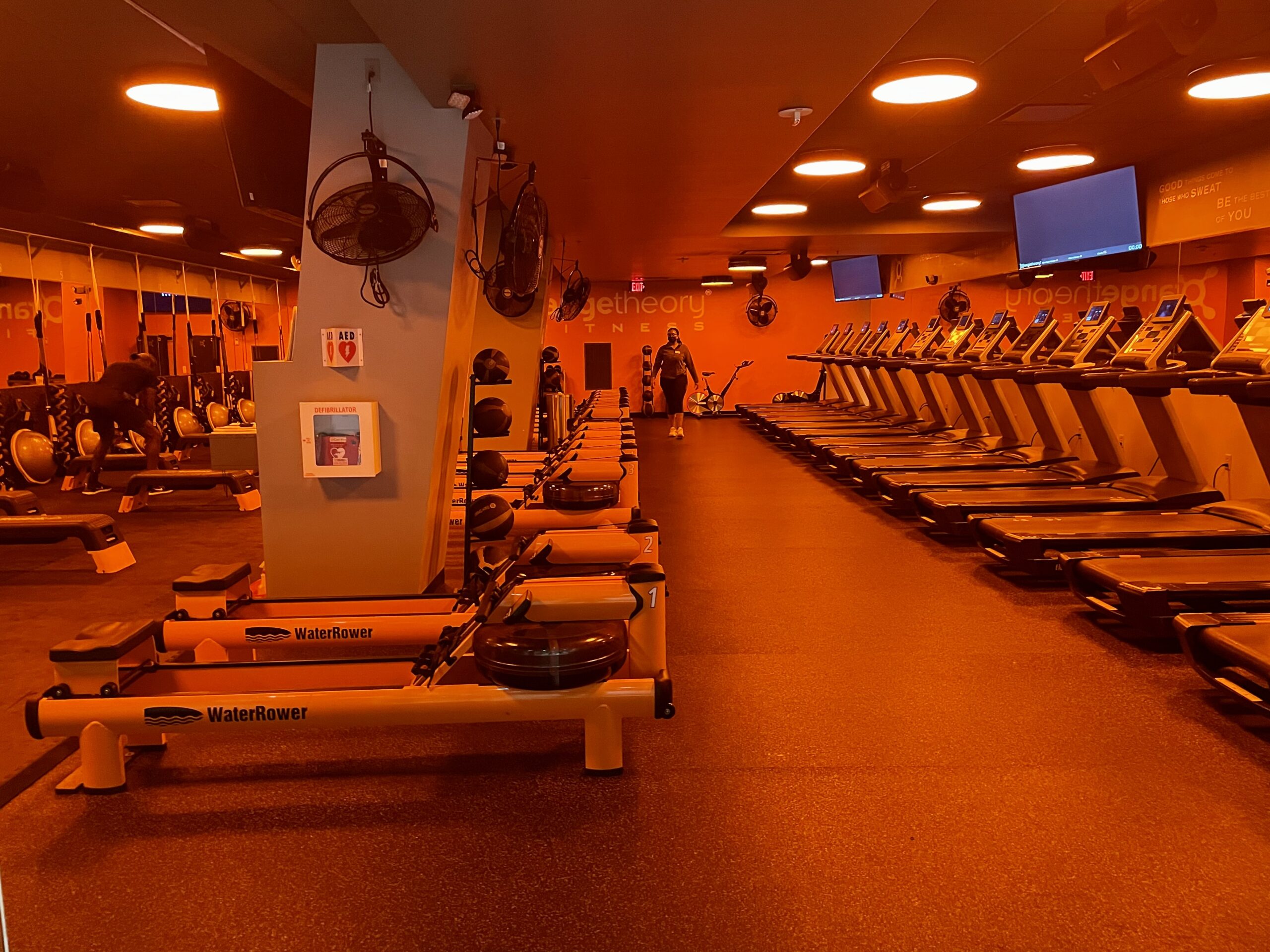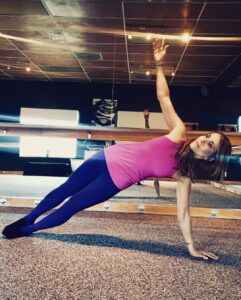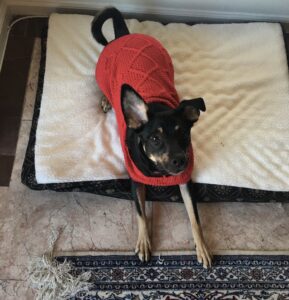If you are looking to get back into the swing of challenging workouts or just to try something new, Orange Theory is a good choice. This post will explain what it is, what the experience is like, and help you figure out if it is right for you.
What is “Orange Theory?”
According to their FAQ, Orange Theory is “a 1 hour, full body workout, focused on training endurance, strength and/or power. We use Heart Rate Based Interval Training, which burns more calories post workout than a traditional exercise. When wearing our Heart Rate monitors, your real time results are displayed on large screens throughout the studio. Intensity is based on your individual Heart Rate zones, making the workout effective for all fitness levels. To top it off, our fitness coaches to lead the workout to prevent you from over or under training.”
Some of you, especially New Yorkers, may immediately jump to the Barry’s Bootcamp comparison. I will probably do a proper post comparing the two, but overall I would say it’s not just a red room versus orange room difference. There is more intentional instruction and variety of equipment at Orange Theory, to sum it up broadly.
What’s the deal with the zones?
As the card below shows, there are 5 zones based on interval training using specifically designed and timed blocks. The workouts are designed to produce 12 minutes or more in Zones 4 & 5 combined (to achieve the after burn) during the treadmill training portion of the workout.

What is the “value prop”?
In my line of work, we are always looking at value prop, value add, value shares. For Orange Theory, it can be summarized in an acronym: EPOC. We talked about this in my DAO of HIIT post. Basically it is an acronym for Excess Post-Oxygen Consumption, which loosely refers to the “after burn” effect of raising your metabolism after a type of workout like Orange Theory where your heartrate is constantly spiking up and then going down.
Another “value add” of OT is that it is akin to personal training, with more personal attention and minimal mental fatigue. All you really have to do is show up with your water bottle and you are good to go. Someone else has figured it all out for you, tells you what to do, and pushes you throughout. For busy professionals, this is ideal. It’s probably the reason why many people I know in professional services are OT fans. You get your cardio and your resistance training in a one stop shop.
Can you do Orange Theory even if you vegged out during COVID?
Again, the FAQs and personal experience confirms yes. One thing I quickly learned by using the Orange Zone metrics, which I will explain, is that the workout is scalable. So do not be intimated if you habven’t done a lot of lifting or intense cardio lately. The workout will be tough, regardless!
My experience as an Orange Theory newbie
I booked a Friday 7:30am class at the Orange Theory West End studio in Washington, D.C. This studio is only a few years old, and I have walked by it numerous times, but I finally pulled the trigger and booked the class so I could give an informed view for my readers. My experience began before I even entered the studio. The Orange Theory team is very attentive and client centered, which I can appreciate being in the professional services industry. The same day I booked the class online, I got a call from the studio asking if I had ever been to a class before. While I had several years ago in Orlando when I was at a conference, it had been a long time so I was considered “new.”
This is a good time to point out that one of my favorite workout strategies while traveling is to find local workout studios in places where I travel. You can usually do a one off class, which guarantees you a focused place to work out rather than having to gamble on the hotel gym quality. Plus, you are motivated to have a place to go. You can find more on this and other travel trips in my DAO of crushing fitness while traveling post.
Back to Orange Theory. Since my memory only recalled the studio being very orange with some treadmill work, I was asked to arrive 30 minutes before the class started so they could explain everything to me as a new class. I thought that was a lot of time, but when I actually showed up at 7:10 on Friday morning, I understood why they needed so much time to explain – there is a lot of equipment and technology to understand.
I was greeted warmly and guided to the studio, where the manager explained the workout, the 5 zones, and introduced me to the coach, CG. CG was tall with an intimidating presence but turned out to be a gentle giant and very attentive to the class, coming around and giving tips on form, encouraging us not to give up, and most importantly, telling us when we had 20, 15, 10 seconds left. When you are gasping for air, this information is very important.
Format of the workout
There are three different stations – rower machine, treadmill, and floor.
If you are picturing a rowing machine like you may see in a regular gym or your parents’ basement, boy are you in for a rude awakening. The rowing machine at OT is a water resistant one which makes it a whole lot harder than a regular rowing machine. This is where they start us new people. Ripping off the band-aid perhaps?
I wasn’t exactly sure how many blocks there were supposed to be or how many were left after each one, so that motivated me to go as hard as I could during the “all out” part of the rowing block. The cardio blocks for both the treadmill and the rowing are designed to go at a hard pace and then an all out pace, the latter being you give it 110 percent and don’t hold back. After the last block, my legs were screaming and my heart rate definitely got up to the Orange Zone at least once. Now, it was time to hit the floor. There is about 30 seconds to collect yourself and transition between stations, but it isn’t a full on rest break.
I felt pretty good about myself at this transition point toward the floor, because I am such a gym rats and can lift heavy weights. So the structure of the floor work was organized into core and upper body mostly we did some planks some half Burpee‘s holds as well as upper body shoulder presses upper cuts and there were a variety of weights we could use from lighter weights up to 25s I immediately grabbed the 20s. By the end of the floor work I was using 12s. I am not used to doing circuit weight training after fatiguing myself with cardio so it was a very big surprise to me that I was feeling super weak and I couldn’t sustain heavy weights for 30 seconds,which CG did warned us about. Even with having to step down in weights, I still felt like I was getting a great resistance workout. One thing I really liked was during each circuit there was a large screen TV flashing up the sequence of the moves with avatar demos. During hard workouts your brain can turn into jelly and it can be difficult to remember even three moves!
Although the floor work was challenging, and there was some plyo, I did feel like my heart rate came down quite a bit. Then, we transitioned to the treadmills, which was the last part of the class for my grouo. The first block of the treadmill was a 3 1/2 minute run with the treadmills we had a choice of doing a brisk walk at a high incline or a run or jog the jog was defined as between 4.5 to 5.5. I started the first block with a jog because it was for 3 1/2 minutes and that’s felt like forever based on how tired I already was high this point my calorie burn was a little bit over 400 but we still had quite a bit of time left in the class then we did a treadmill intervals and I kept going faster and faster with an ability to get my pace up to 9mph. For some of you that may be a jog, but for me that is super fast. That is why the workout is scalable – it is all relative!!
How you feel after class
I got up in the red zone a few times which was good by the end of the class I felt invigorated I was very sweaty and I refilled my water bottle up twice as we cool down. CG also took the time after class to explain my stats, which I have pictured here. Apparently I hit the goal of getting 12 splat points, which means I was in the Orange Zone or more for 12 minutes or more.
While I appreciate the metrics, I don’t wear a fitness tracker or pay that much attention to numbers. I always care more about the joyful movement and know when I am being challenged. It is good to understand what the benchmarks are, but no need to obsess about getting to any marker. You know when you are sweaty and have a pounding chest that you have had a good workout!

Membership options
You can always drop in on classes (prices vary depending on area), and OT also has class pack and monthly membership options. The monthly membership option prices are comparable to what you would pay for a big box gym membership, so if you already have one of those, class packs may be a better way to go.

Bottom line
Overall, I would highly recommend that if you do start to travel again or if you have an Orange Theory area in your area, give it a shot and see what you think. I felt pretty great all day. I woke up this morning as I am writing the review I am comfortably sore but not in any kind of major pain. I really enjoyed my experience and would highly recommend orange theory. You can find out more about orange theory on their website here and there are also other reviews of orange theory here.






